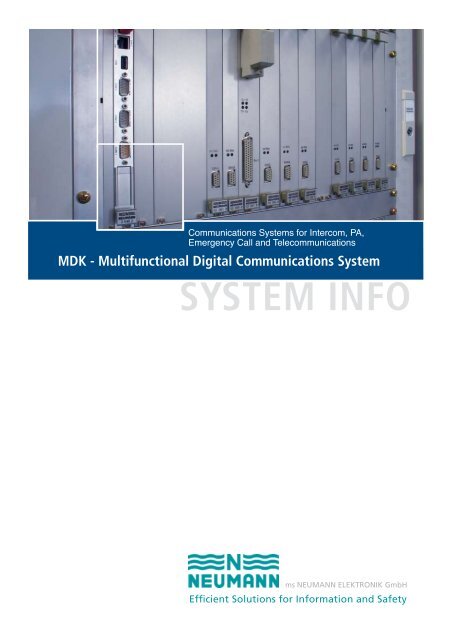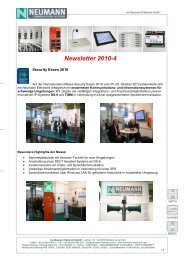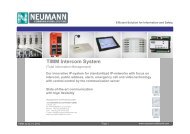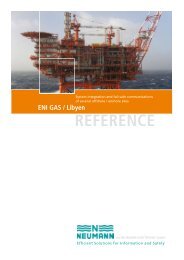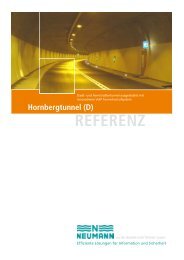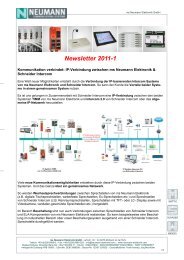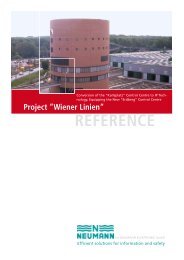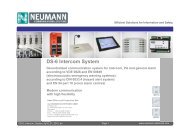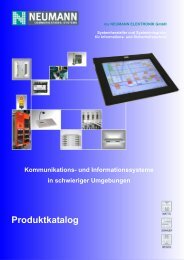SYSTEM INFO - Neumann Elektronik
SYSTEM INFO - Neumann Elektronik
SYSTEM INFO - Neumann Elektronik
You also want an ePaper? Increase the reach of your titles
YUMPU automatically turns print PDFs into web optimized ePapers that Google loves.
Communications Systems for Intercom, PA,<br />
Emergency Call and Telecommunications<br />
MDK - Multifunctional Digital Communications System<br />
<strong>SYSTEM</strong> <strong>INFO</strong><br />
ms NEUMANN ELEKTRONIK GmbH<br />
Efficient Solutions for Information and Safety
MDK –<br />
Multifunctional Digital Communications System<br />
The Multifunctional Digital Com-<br />
munications System is a centrally<br />
controlled voice communications<br />
system that has been designed to<br />
fulfil all audio applications. The<br />
MDK serves as the central exchange<br />
for intercom, public address (PA),<br />
emergency call and telecommuni-<br />
cations functions. The MDK can be<br />
used for all such applications in in-<br />
dustry and public transport, inclu-<br />
ding those that require the highest<br />
reliability and safety standards.<br />
Complex Applications<br />
The modularly designed communi-<br />
cations system is ideally suited for<br />
complex applications in the Rail-<br />
ways/Public Transport sector, as<br />
well as in the Industrial sector. In<br />
Railways/Public Transport systems,<br />
the MDK System finds use as a dis-<br />
patcher system for communications<br />
along railway lines, and as a voice<br />
communications system in 3S con-<br />
trol centres. In Industry, it is used to<br />
implement very extensive PA/inter-<br />
com applications.<br />
Emergency Call /<br />
Info Systems<br />
In addition to expecting higher<br />
safety standards in public trans-<br />
port systems, customers are also<br />
asking for more comprehensive<br />
information. ms <strong>Neumann</strong> provides<br />
extensive emergency call and information<br />
systems that can be implemented<br />
based entirely on MDK<br />
Systems.<br />
Safety in tunnels has become a particularly<br />
important issue in recent<br />
times. Special design emergency<br />
call systems, where the call boxes<br />
also contain monitored fire extinguishers,<br />
can be monitored and<br />
controlled with the MDK System.<br />
Emergency Warning<br />
System<br />
The MDK can be modularly configured<br />
as a plant warning system<br />
or emergency warning system that<br />
complies with the DIN EN 60849/<br />
VDE 0828, Part 1 standard.<br />
Innovative<br />
Communications<br />
Exchange Structure<br />
Further features of this system are<br />
its exchange capabilities for intercom<br />
and public address (PA) connections.<br />
Both analogue and digital<br />
devices can be connected to the<br />
MDK. The system also offers plugin<br />
modules to connect all analogue<br />
telephone equipment and existing<br />
multiparty lines to the MDK. In addition,<br />
radio system interfaces enable<br />
it to integrate the most common<br />
radio and wireless systems<br />
– regardless of whether analogue<br />
or digital. Its standard digital interfaces<br />
(per DSS1) enable all digital<br />
telecommunication terminal devices<br />
to be connected to the MDK,<br />
as well as digital PABX systems.<br />
All intercom call stations already installed<br />
in existing intercom systems<br />
from ms <strong>Neumann</strong> <strong>Elektronik</strong> are<br />
fully compatible to the new analogue<br />
intercom call stations and can<br />
thus be connected to the MDK.<br />
Excellent Speech<br />
Intelligibility<br />
Good intercom and PA speech intelligibility<br />
is guaranteed by the<br />
system’s increased bandwidth of 7<br />
kHz.<br />
Modular, Versatile and<br />
Innovative<br />
The modular design of the system<br />
ensures its exceptional versatility.<br />
This modular design also enables<br />
the system to always be able to<br />
take advantage of new, innovative<br />
developments in wired communications<br />
technology.
The Multifunctional Digital<br />
Communications System (MDK)<br />
The basic configuration of the<br />
MDK System consists of a base unit<br />
(exchange) that can simultaneous-<br />
ly switch various connections to<br />
intercom/PA devices and to tele-<br />
phone lines. Several of these base<br />
units located at different sites can<br />
also be interconnected via digital<br />
interfaces (S2M). The terminal de-<br />
vices of every base unit can then<br />
be accessed from any other unit<br />
connected to the system. Digital<br />
interconnections via S0 and S2M in-<br />
terfaces enable telephone connec-<br />
tions to be made to PABX systems<br />
from every MDK base unit. Networ-<br />
king can be implemented either via<br />
fibre optic or copper cables (see di-<br />
agram under “Network Structure”<br />
later in this document). To further<br />
ensure reliable transmission paths,<br />
the base units are interconnected<br />
in a ring network topology.<br />
Highest Reliability<br />
ms <strong>Neumann</strong> <strong>Elektronik</strong> offers<br />
communications systems that have<br />
been specially tailored to meet our<br />
customer’s requirements for reli-<br />
ability. On request, we can provi-<br />
de configurations into which two<br />
exchange control units have been<br />
integrated to implement a redun-<br />
dant processor system.
System Architecture
Structure of the MDK System Base Unit<br />
n<br />
n<br />
n<br />
n<br />
n<br />
n<br />
n<br />
n<br />
n<br />
Modular design using plug-in modules<br />
Two different bus systems: VME bus and MDK bus<br />
VME bus as the control bus for the base unit (Versa Module Eurocard)<br />
· Exceptionally versatile<br />
· High reliability standards<br />
· Very good EMC<br />
· Low energy consumption due to active termination<br />
· Fast access times<br />
MDK bus for data transport between the digital<br />
coupling matrix and the terminal device line connection modules<br />
within the locally installed system<br />
Up to three bus systems: Master, Slave 1 and Slave 2<br />
Data transported on 16 highways with 32 channels each (PCM 32)<br />
3 system plug-in module levels Master, Slave 1 and Slave 2<br />
Smallest configuration is one Master module with up to<br />
8 line connection modules<br />
Up to 32 line connection modules in the entire line connection section<br />
Up to 7 S2M interfaces can be used as needed<br />
One digital audio storage module can be installed
Network Structure<br />
MF Concentrator for multiple telephone/intercom lines<br />
MZV Microprocessor-Controlled Central Exchange System<br />
EZV Electronic Central Exchange System<br />
MDK Multifunctional Digital Communications System<br />
ZZ System interconnection interface<br />
TA-ZZ Terminal adapter for system interconnections
MDK Terminal Units
Technical Highlights at a Glance<br />
Multifunctional desktop call station<br />
MTSD (digital)<br />
PC call station with touch screen<br />
Emergency call system in tunnels<br />
Emergency call and information call system<br />
Process oriented communication<br />
Control of alarm events and sequence of responses<br />
Telephone announcements transmitted to loudspeaker circuits<br />
Automated announcements<br />
Telecommunications, intercom, PA and control functions<br />
united in one exchange system<br />
Up to 128 intercom/PA devices connected to one exchange<br />
without blocking each other<br />
Up to 256 telephone lines connected to one exchange without<br />
blocking each other<br />
Up to 10 MDK Exchanges can be interconnected via routing<br />
Virtually unrestricted access to other telephone systems via<br />
connection to external PABX systems<br />
Management System application for supervisory control<br />
ntegrates many different interfaces: S2M, So, U, RS232, RS422, a/b, lines, etc.<br />
Long service life due to low heat technology<br />
High transmission bandwidth for intercom and PA<br />
GSM, DECT/ ISDN implementation<br />
Connection to fire alarm systems<br />
Remote diagnosis/maintenance, remote configuration using<br />
PC user interface software<br />
Terminal devices of all generations from analogue to digital can be connected<br />
Several MDKs can be networked together via the S2M interfaces<br />
Gateway for H.232 protocol<br />
Very good EMC due to low processor clock speed
The Most Important Functions<br />
Intercom and PA Technology<br />
Flashing indicator signals incoming call at call station<br />
Constantly lit indicator signals line engaged at call station<br />
Indicator flashes at four different frequencies to indicate<br />
status of various functions<br />
256 assignable priority levels for call override<br />
A call station assigned a higher priority can override and interrupt an<br />
active intercom connection from a lower priority station. The higher<br />
priority station is then switched immediately through to the destination.<br />
An active connection can be reserved for a configurable length of time<br />
(operator station function). At the control centre, all operator stations have<br />
equal priority, and these call stations can communicate with each other. An<br />
active intercom connection at one of these stations can be reserved to<br />
remain connected for the reserved length of time so that no other call<br />
station can interrupt the conversation.<br />
Collective calls (all stations called), and predefined group calls<br />
Call stations can be added to a group call by pressing a button<br />
Call on hold functions<br />
• Active call can be put on hold by single incoming call<br />
• Active call can be put on hold by call waiting<br />
• Active call can be put on hold during group call by group call participants<br />
• Active call can be put on hold by call line (only signalling function)<br />
Call waiting<br />
Time scheduled volume lowering, e.g. for announcements (nighttime low<br />
volume setting)<br />
Time scheduled cyclic audio output from the digital audio storage module<br />
Service connections between control centre and service personnel<br />
Talk direction of intercom connections on hold can be controlled from<br />
one end<br />
Entrance (door/gate) intercom function<br />
Paging loudspeaker function<br />
Talk direction of intercom connection can be controlled from one end<br />
Different text messages can be output to the displays of digital call stations<br />
for different events and functions<br />
Functions to ensure reliable PA announcement transmission<br />
• Functional monitoring of amplifiers with automatic switchover to<br />
backup amplifier<br />
• Loudspeaker connections monitored by measurement of loudspeaker<br />
circuit impedance<br />
• Automatic gain control of amplifier as a function of ambient noise levels
Emergency Call Functions<br />
Any incoming call can be defined as an “emergency call” based on the<br />
destination telephone number<br />
Emergency call signalling with a special display of the pillar designation<br />
from which the call originated (e.g. location) based on the source<br />
telephone number<br />
Fault signalling generated by cyclic functional monitoring<br />
Every emergency call is signalled, even when the operator station or audio<br />
frequency channel is engaged, because the operator stations can be set up<br />
to be reachable at all times<br />
Every emergency call can be accepted either in chronological order or<br />
any order<br />
Every emergency call can be forwarded (manually or automatically) to any<br />
other ISDN terminal devices<br />
Emergency calls coming in at the same time can be accepted and put<br />
on hold<br />
Operators can also call back to emergency call pillars<br />
Video connections can be controlled (manually or via the Management<br />
System application)<br />
Calls can be automatically forwarded to a backup operator station when an<br />
operator station fails<br />
A redundant telephone to answer emergency calls can be set up using eit<br />
her a standard ISDN telephone, or<br />
Using a <strong>Neumann</strong> MDK System Telephone connected to its own So interface<br />
Recording of call conversations to external recording devices can be<br />
activated automatically<br />
Call and connection data can be logged (with telephone number and<br />
time stamp)<br />
Telephone Functions<br />
Digital telephone service features and functions as per DSS1<br />
Functions and technical features of analogue telephones and<br />
terminal devices as per 1 TR2
System Features<br />
Nominal operating voltage:<br />
• 48 V (+12 %, -10 %), or<br />
• 60 V.. (+12 %, -10 %)<br />
Climate class: 3K4 as per DIN IEC 721, Part 3-3<br />
Type of modulation: PCM in time multiplexed technique as per CCITT<br />
CODEC: A-Law as per CCITT recommendation G711<br />
Internal digital transmission format: PCM32<br />
Digital telecommunications interfaces as per ISDN standard (So, U; S2M), ISDN protocols per: 1TR6 and DSS1<br />
BZT general certification: Cert. No.: A122083H for 1TR6<br />
Voice transmission bandwidth for telecommunications: standard ISDN<br />
Voice transmission bandwidth for intercom/PA: approx. 7 kHz<br />
Maximum of 256 telephones or 128 intercom/PA devices connectable to one base unit without blocking each other.<br />
The number of devices can be freely mixed between the two technologies (analogue and digital).<br />
Maximum of 10 base units can be interconnected in a ring topology.<br />
Maximum number of addressable telephones lines: 2,560; Max. number of intercom/PA devices: 1,280<br />
Maximum intercom/PA line connection time on a fully loaded system: 200 ms<br />
Maximum of 7 S2M interfaces per base unit<br />
Digital audio storage in EPROM and/or RAM; voice signal from call station is stored directly into memory<br />
Logged events are time stamped using either:<br />
• the time from a built-in radio synchronised clock, or<br />
• the system time synchronised by an external clock (synchronisation messages from the network,<br />
or synchronisation by clock pulses (minute intervals))<br />
Long-term and short-term logging systems can be connected to the MDK<br />
System controllable from a supervisory computer (Management System) via RS232C (serial) interface<br />
Siedle call stations can be connected<br />
Microphone/earphone headsets can be connected<br />
Analogue and digital radiotelephone systems can be connected<br />
PC call stations with touch screen can be connected for intercom, PA and telephony functions<br />
Service interface for system diagnosis integrated into every base unit can be read out by a PC via a monitor<br />
program implemented in firmware or via a program with graphical user interface running on Windows 95…XP<br />
Plug-in line connection modules can be hot swapped on a running system. No reset required because the modules<br />
are self initialising.<br />
The MDK is freely configurable using a PC program with graphical user interface<br />
Configuration data transferable using a standard PC card (memory card), or via a network interface<br />
Supports remote diagnosis and remote configuration<br />
MDK utilises two user access tables that can be time scheduled to be activated at different times.
Applications<br />
Railways<br />
Public Transport<br />
Energy, Public Utility, and Waste Disposal Industries<br />
Waterways and Inland Shipping Routes<br />
Heavy Industry<br />
Chemical Industry<br />
Oil & Gas<br />
Motorways<br />
Tunnels


